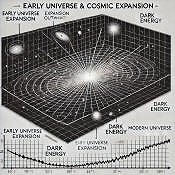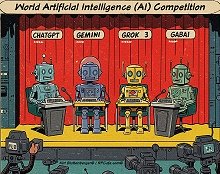Electronics & Technology
- See Full List of AI Topics -
 Dark energy is one of the most profound and enigmatic concepts in modern cosmology,
embodying the mystery of the accelerated expansion of the universe. Its origins
trace back to the early 20th century when Albert Einstein introduced the concept
of the cosmological constant, represented by the Greek letter Lambda (Λ), in his
equations of General Relativity. Einstein initially formulated this constant to
balance the force of gravity and achieve a static universe, which was the prevailing
cosmological model at the time. However, after Edwin Hubble's discovery in 1929
that the universe was expanding, Einstein reportedly dismissed the cosmological
constant as his "greatest blunder." Yet, as history would reveal, this concept would
resurface as a cornerstone of modern cosmology. Dark energy is one of the most profound and enigmatic concepts in modern cosmology,
embodying the mystery of the accelerated expansion of the universe. Its origins
trace back to the early 20th century when Albert Einstein introduced the concept
of the cosmological constant, represented by the Greek letter Lambda (Λ), in his
equations of General Relativity. Einstein initially formulated this constant to
balance the force of gravity and achieve a static universe, which was the prevailing
cosmological model at the time. However, after Edwin Hubble's discovery in 1929
that the universe was expanding, Einstein reportedly dismissed the cosmological
constant as his "greatest blunder." Yet, as history would reveal, this concept would
resurface as a cornerstone of modern cosmology.
The theory of dark energy began to take shape in the late 20th century when observational
evidence started to indicate that the universe's expansion was not slowing down
due to gravitational attraction, as many scientists had assumed, but was accelerating.
In the 1990s, two independent research teams, the Supernova Cosmology Project led
by Saul Perlmutter and the High-Z Supernova Search Team led by Brian Schmidt and
Adam Riess, analyzed distant Type Ia supernovae, which serve as standard candles
for measuring cosmic distances. Their groundbreaking findings, published in 1998,
showed that these supernovae were dimmer than expected, implying that the expansion
of the universe was accelerating. This discovery earned Perlmutter, Schmidt, and
Riess the Nobel Prize in Physics in 2011.
The notion of dark energy was introduced as a way to explain this acceleration.
Dark energy is thought to constitute approximately 68% of the total energy density
of the universe, dwarfing the contributions of ordinary matter and dark matter.
It is characterized as a form of energy that permeates all of space, exerting a
repulsive force that counteracts gravity on cosmic scales. This repulsive force
is often associated with the vacuum energy predicted by quantum field theory, though
the exact nature of dark energy remains unknown.
Over time, the theory of dark energy has evolved, incorporating contributions
from various scientific disciplines. The cosmological constant Λ remains one of
the simplest explanations, consistent with observations of the cosmic microwave
background (CMB) radiation, galaxy clustering, and large-scale structure. However,
alternative models have also been proposed. These include quintessence, a dynamic
field that changes over time, and modifications to General Relativity that could
account for the observed acceleration without invoking a separate form of energy.
Experimental support for dark energy comes from multiple sources. Observations
of the CMB by experiments such as the Wilkinson Microwave Anisotropy Probe (WMAP)
and the Planck satellite have provided precise measurements of the universe's composition,
showing that dark energy is consistent with a flat, Λ-dominated cosmological model.
Additionally, large-scale surveys of galaxies, such as the Sloan Digital Sky Survey
(SDSS) and the Dark Energy Survey (DES), have mapped the distribution of matter
in the universe, further corroborating the role of dark energy in shaping cosmic
evolution.
The concept of dark energy is not without controversy. It has been described
by some as a "fudge factor," echoing Einstein's initial use of the cosmological
constant to fit theoretical models to observational data. Critics argue that the
introduction of dark energy highlights gaps in our understanding of fundamental
physics, potentially pointing to new physics beyond the Standard Model. Disagreements
also exist regarding its compatibility with a unified model of the universe. While
dark energy fits within the framework of the Big Bang theory and the inflationary
model, it raises questions about the ultimate fate of the universe. Scenarios such
as the Big Freeze, Big Rip, and Big Crunch hinge on the properties of dark energy,
particularly its equation of state and whether it remains constant over time.
Dark energy is deeply intertwined with the concept of missing energy in the universe.
Observations indicate that only about 5% of the universe's total energy density
is composed of ordinary, baryonic matter. The remaining 95% is split between dark
matter and dark energy, with the latter accounting for the lion's share. This realization
has revolutionized cosmology, shifting the focus from visible matter to the unseen
forces and substances that govern the cosmos.
Despite its central role in modern cosmology, dark energy remains one of the
greatest mysteries in science. Its discovery has spurred countless experiments and
theoretical investigations, yet its true nature eludes definitive explanation. Whether
it is a manifestation of vacuum energy, a new field, or a sign of deeper modifications
to our understanding of gravity, dark energy continues to challenge and inspire
scientists to push the boundaries of human knowledge.
Skeptics of dark energy have raised several compelling arguments over the years,
questioning both its existence and the assumptions underlying its theoretical framework.
One of the primary concerns is that dark energy may not be a real entity but rather
a symptom of inadequacies in our understanding of gravity and cosmology. Modified
gravity theories, such as those proposed in the frameworks of MOND (Modified Newtonian
Dynamics) or TeVeS (Tensor-Vector-Scalar gravity), suggest that the observed accelerated
expansion of the universe might be explained by altering the laws of gravity rather
than invoking an entirely new form of energy. These alternative theories aim to
reproduce the effects attributed to dark energy without requiring an exotic substance,
though they often struggle to match the broad range of observational data as well
as the ΛCDM model does.
Another point raised by skeptics is that the evidence for dark energy is highly
indirect, relying on interpretations of observational data that are dependent on
numerous assumptions. For instance, the accelerated expansion inferred from supernova
observations hinges on the assumption that Type Ia supernovae are perfect standard
candles, with minimal variability over cosmic timescales. While extensive calibration
efforts have supported this assumption, skeptics argue that even small deviations
could significantly impact the conclusions about cosmic acceleration. Similarly,
measurements of the cosmic microwave background and galaxy distributions depend
on the standard cosmological model, which itself assumes the existence of dark energy.
Critics suggest that our current observational tools may be insufficient to definitively
prove the existence of dark energy, leaving open the possibility that other explanations
- whether systemic biases, data interpretation errors, or unrecognized physical
processes - might account for the observed phenomena.
These skeptical perspectives highlight the profound challenges in exploring the
deepest questions about the universe. While the majority of the scientific community
supports the concept of dark energy due to its explanatory power and consistency
with observations, skeptics serve as a reminder of the importance of questioning
assumptions and remaining open to new ideas that could reshape our understanding
of the cosmos. Their critiques drive researchers to refine their models, improve
observational techniques, and continue seeking the fundamental truths about the
universe's structure and evolution.
 This content was generated by primarily
the ChatGPT (OpenAI), and/or
Gemini (Google), and/or
Arya (GabAI), and/or
Grok (x.AI), and/or DeepSeek artificial intelligence (AI) engine.
Some review was performed to help detect and correct any inaccuracies; however,
you are encouraged to verify the information yourself if it will be used for critical
applications. In some cases, multiple solicitations to the AI engine(s) was(were) used to assimilate
final content. Images and external hyperlinks have also been added occasionally.
Courts have ruled that AI-generated content is not subject to copyright restrictions,
but since I modify them, everything here is protected by RF Cafe copyright. Many
of the images are likewise generated and modified. Your use of this data implies
an agreement to hold totally harmless Kirt Blattenberger, RF Cafe, and any and all
of its assigns. Thank you. Here are the major categories. This content was generated by primarily
the ChatGPT (OpenAI), and/or
Gemini (Google), and/or
Arya (GabAI), and/or
Grok (x.AI), and/or DeepSeek artificial intelligence (AI) engine.
Some review was performed to help detect and correct any inaccuracies; however,
you are encouraged to verify the information yourself if it will be used for critical
applications. In some cases, multiple solicitations to the AI engine(s) was(were) used to assimilate
final content. Images and external hyperlinks have also been added occasionally.
Courts have ruled that AI-generated content is not subject to copyright restrictions,
but since I modify them, everything here is protected by RF Cafe copyright. Many
of the images are likewise generated and modified. Your use of this data implies
an agreement to hold totally harmless Kirt Blattenberger, RF Cafe, and any and all
of its assigns. Thank you. Here are the major categories.
Electronics & High Tech
Companies | Electronics &
Tech Publications | Electronics &
Tech Pioneers | Electronics &
Tech Principles |
Tech Standards Groups &
Industry Associations | Societal
Influences on Technology
|








